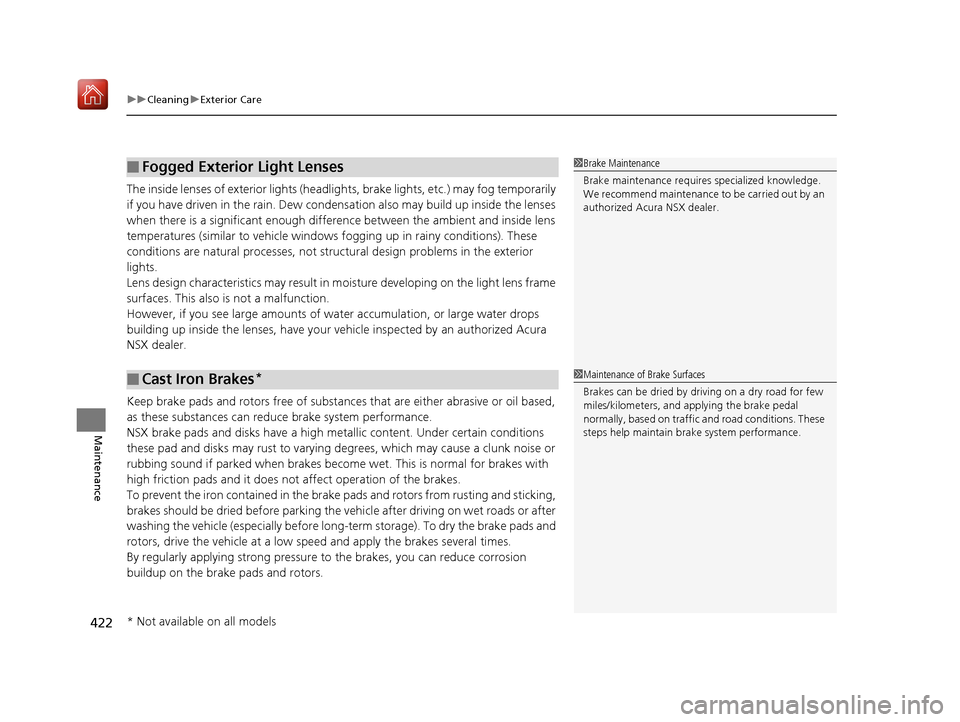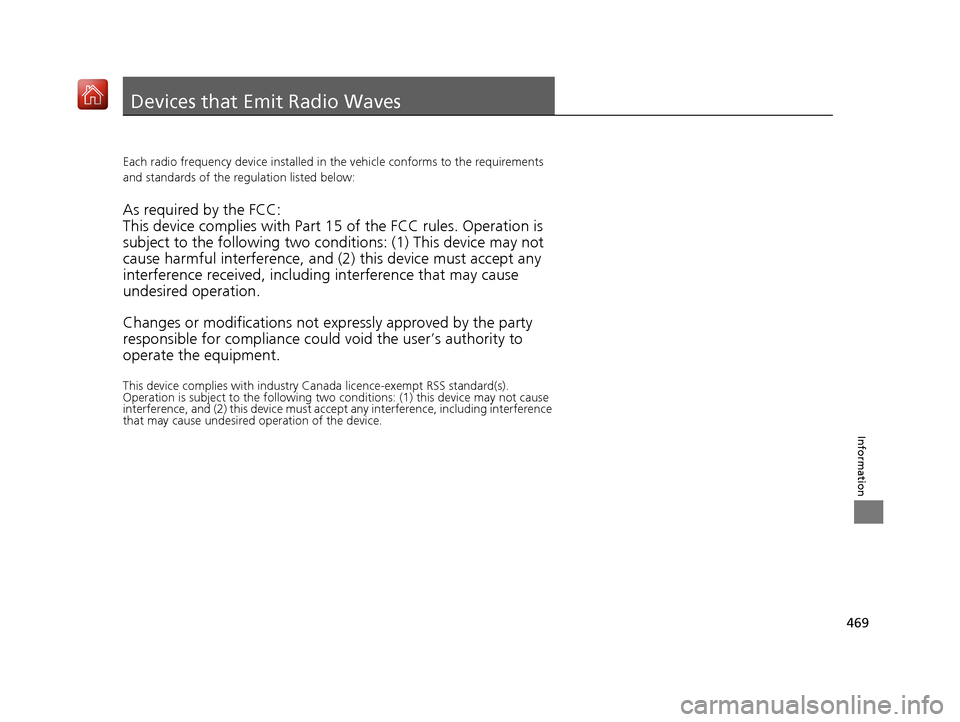ESP Acura NSX 2019 Owner's Guide
[x] Cancel search | Manufacturer: ACURA, Model Year: 2019, Model line: NSX, Model: Acura NSX 2019Pages: 485, PDF Size: 27.6 MB
Page 410 of 485

409
uuChecking and Maintaining Tires uDOT Tire Quality Grading (U.S. Vehicles)
Maintenance
The traction grades, from highest to lowest, are AA, A, B, and C.
Those grades represent the tire’s ability to stop on wet pavement
as measured under controlled conditions on specified
government test surfaces of asph alt and concrete. A tire marked
C may have poor traction performance.
The temperature grades are A (the highest), B, and C,
representing the tire’s resistance to the generation of heat and its
ability to dissipate heat when te sted under controlled conditions
on a specified indoor laboratory test wheel. Sustained high
temperature can cause the material of the tire to degenerate and
reduce tire life, and ex cessive temperature can lead to sudden tire
failure. The grade C corresponds to a level of performance which
all passenger car tires must meet under the Federal Motor Vehicle
Safety Standard No. 109. Grades B and A represent higher levels
of performance on the laboratory test wheel than the minimum
required by law.
■Traction
■Temperature
1 Traction
Warning: The traction grade
assigned to this tire is based on
straight-ahead braking traction tests,
and does not include acceleration,
cornering, hydroplaning, or peak
traction characteristics.
1Temperature
Warning: The temperature grade for
this tire is establishe d for a tire that is
properly inflated and not
overloaded. Excessive speed,
underinflation, or excessive loading,
either separately or in combination,
can cause heat buildup and possible
tire failure.
19 NSX-31T6N6200.book 409 ページ 2018年8月9日 木曜日 午前11時12分
Page 423 of 485

uuCleaning uExterior Care
422
Maintenance
The inside lenses of exterior lights (headlig hts, brake lights, etc.) may fog temporarily
if you have driven in the rain. Dew condensation also may build up inside the lenses
when there is a significant enough differe nce between the ambient and inside lens
temperatures (similar to vehicle windows fogging up in rainy conditions). These
conditions are natural processes, not stru ctural design problems in the exterior
lights.
Lens design characteristics may result in mo isture developing on the light lens frame
surfaces. This also is not a malfunction.
However, if you see large amounts of wa ter accumulation, or large water drops
building up inside the lenses, have your vehicle inspected by an authorized Acura
NSX dealer.
Keep brake pads and rotors free of substances that are either abrasive or oil based,
as these substances can re duce brake system performance.
NSX brake pads and disks have a high meta llic content. Under certain conditions
these pad and disks may rust to varying degrees, which may cause a clunk noise or
rubbing sound if parked when brakes become wet. This is normal for brakes with
high friction pads and it does not affect operation of the brakes.
To prevent the iron contained in the brake pads and rotors from rusting and sticking,
brakes should be dried before parking the ve hicle after driving on wet roads or after
washing the vehicle (especially before long -term storage). To dry the brake pads and
rotors, drive the vehicle at a low sp eed and apply the brakes several times.
By regularly applying strong pressure to the brakes, you can reduce corrosion
buildup on the brake pads and rotors.
■Fogged Exterior Light Lenses
■Cast Iron Brakes*
1 Brake Maintenance
Brake maintenance require s specialized knowledge.
We recommend maintenance to be carried out by an
authorized Acura NSX dealer.
1 Maintenance of Brake Surfaces
Brakes can be dried by driv ing on a dry road for few
miles/kilometers, and a pplying the brake pedal
normally, based on traffic and road conditions. These
steps help maintain br ake system performance.
* Not available on all models
19 NSX-31T6N6200.book 422 ページ 2018年8月9日 木曜日 午前11時12分
Page 470 of 485

469
Information
Devices that Emit Radio Waves
Each radio frequency device installed in the vehicle conforms to the requirements
and standards of the regulation listed below:
As required by the FCC:
This device complies with Part 15 of the FCC rules. Operation is
subject to the following two cond itions: (1) This device may not
cause harmful interferenc e, and (2) this device must accept any
interference received, including interference that may cause
undesired operation.
Changes or modifications not ex pressly approved by the party
responsible for compliance could void the user’s authority to
operate the equipment.
This device complies with industry Canada licence-exempt RSS standard(s).
Operation is subject to the following two conditions: (1) this device may not cause
interference, and (2) this device must accept any interference, including interference
that may cause undesired operation of the device.
19 NSX-31T6N6200.book 469 ページ 2018年8月9日 木曜日 午前11時12分